Tarek Abdelzaher
CSRAP: Enhanced Canvas Attention Scheduling for Real-Time Mission Critical Perception
Aug 07, 2025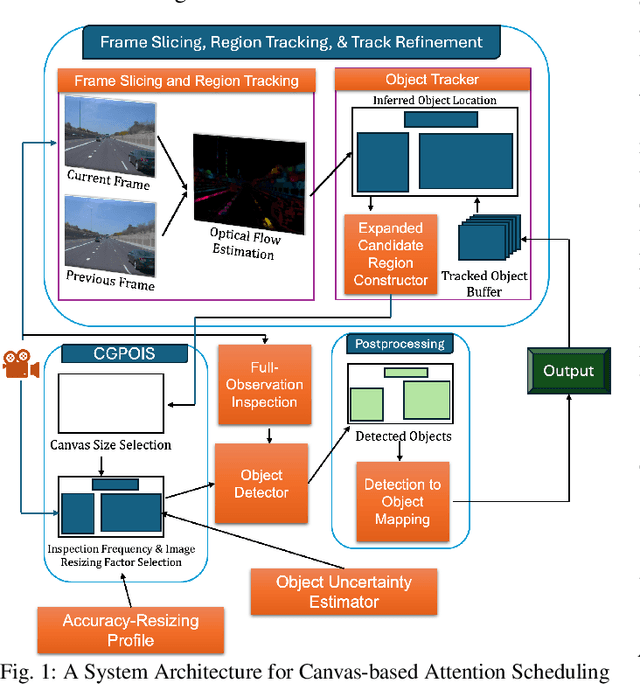
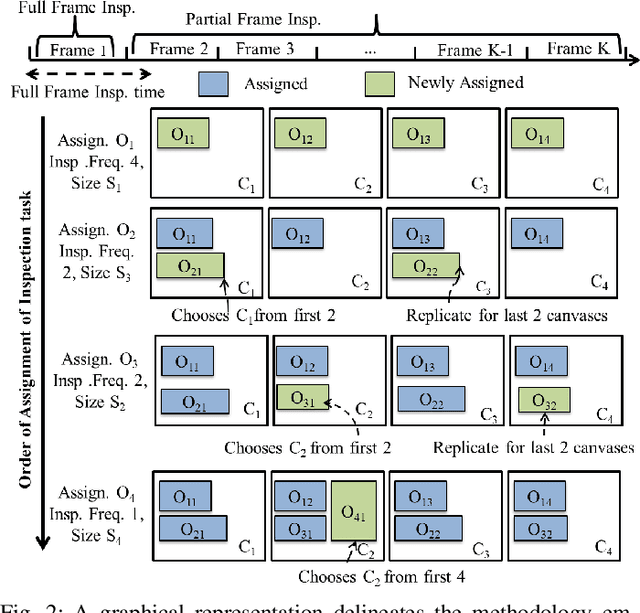
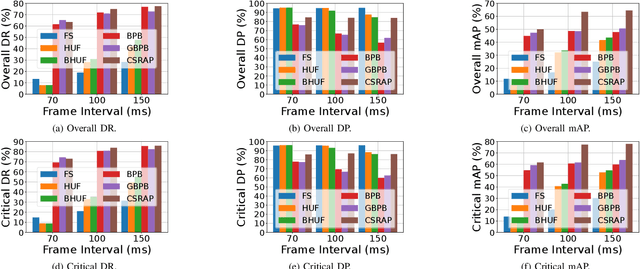

Abstract:Real-time perception on edge platforms faces a core challenge: executing high-resolution object detection under stringent latency constraints on limited computing resources. Canvas-based attention scheduling was proposed in earlier work as a mechanism to reduce the resource demands of perception subsystems. It consolidates areas of interest in an input data frame onto a smaller area, called a canvas frame, that can be processed at the requisite frame rate. This paper extends prior canvas-based attention scheduling literature by (i) allowing for variable-size canvas frames and (ii) employing selectable canvas frame rates that may depart from the original data frame rate. We evaluate our solution by running YOLOv11, as the perception module, on an NVIDIA Jetson Orin Nano to inspect video frames from the Waymo Open Dataset. Our results show that the additional degrees of freedom improve the attainable quality/cost trade-offs, thereby allowing for a consistently higher mean average precision (mAP) and recall with respect to the state of the art.
DocCHA: Towards LLM-Augmented Interactive Online diagnosis System
Jul 10, 2025Abstract:Despite the impressive capabilities of Large Language Models (LLMs), existing Conversational Health Agents (CHAs) remain static and brittle, incapable of adaptive multi-turn reasoning, symptom clarification, or transparent decision-making. This hinders their real-world applicability in clinical diagnosis, where iterative and structured dialogue is essential. We propose DocCHA, a confidence-aware, modular framework that emulates clinical reasoning by decomposing the diagnostic process into three stages: (1) symptom elicitation, (2) history acquisition, and (3) causal graph construction. Each module uses interpretable confidence scores to guide adaptive questioning, prioritize informative clarifications, and refine weak reasoning links. Evaluated on two real-world Chinese consultation datasets (IMCS21, DX), DocCHA consistently outperforms strong prompting-based LLM baselines (GPT-3.5, GPT-4o, LLaMA-3), achieving up to 5.18 percent higher diagnostic accuracy and over 30 percent improvement in symptom recall, with only modest increase in dialogue turns. These results demonstrate the effectiveness of DocCHA in enabling structured, transparent, and efficient diagnostic conversations -- paving the way for trustworthy LLM-powered clinical assistants in multilingual and resource-constrained settings.
PASS: Private Attributes Protection with Stochastic Data Substitution
Jun 08, 2025Abstract:The growing Machine Learning (ML) services require extensive collections of user data, which may inadvertently include people's private information irrelevant to the services. Various studies have been proposed to protect private attributes by removing them from the data while maintaining the utilities of the data for downstream tasks. Nevertheless, as we theoretically and empirically show in the paper, these methods reveal severe vulnerability because of a common weakness rooted in their adversarial training based strategies. To overcome this limitation, we propose a novel approach, PASS, designed to stochastically substitute the original sample with another one according to certain probabilities, which is trained with a novel loss function soundly derived from information-theoretic objective defined for utility-preserving private attributes protection. The comprehensive evaluation of PASS on various datasets of different modalities, including facial images, human activity sensory signals, and voice recording datasets, substantiates PASS's effectiveness and generalizability.
Atomic Reasoning for Scientific Table Claim Verification
Jun 08, 2025Abstract:Scientific texts often convey authority due to their technical language and complex data. However, this complexity can sometimes lead to the spread of misinformation. Non-experts are particularly susceptible to misleading claims based on scientific tables due to their high information density and perceived credibility. Existing table claim verification models, including state-of-the-art large language models (LLMs), often struggle with precise fine-grained reasoning, resulting in errors and a lack of precision in verifying scientific claims. Inspired by Cognitive Load Theory, we propose that enhancing a model's ability to interpret table-based claims involves reducing cognitive load by developing modular, reusable reasoning components (i.e., atomic skills). We introduce a skill-chaining schema that dynamically composes these skills to facilitate more accurate and generalizable reasoning with a reduced cognitive load. To evaluate this, we create SciAtomicBench, a cross-domain benchmark with fine-grained reasoning annotations. With only 350 fine-tuning examples, our model trained by atomic reasoning outperforms GPT-4o's chain-of-thought method, achieving state-of-the-art results with far less training data.
SPAR: Self-supervised Placement-Aware Representation Learning for Multi-Node IoT Systems
May 22, 2025Abstract:This work develops the underpinnings of self-supervised placement-aware representation learning given spatially-distributed (multi-view and multimodal) sensor observations, motivated by the need to represent external environmental state in multi-sensor IoT systems in a manner that correctly distills spatial phenomena from the distributed multi-vantage observations. The objective of sensing in IoT systems is, in general, to collectively represent an externally observed environment given multiple vantage points from which sensory observations occur. Pretraining of models that help interpret sensor data must therefore encode the relation between signals observed by sensors and the observers' vantage points in order to attain a representation that encodes the observed spatial phenomena in a manner informed by the specific placement of the measuring instruments, while allowing arbitrary placement. The work significantly advances self-supervised model pretraining from IoT signals beyond current solutions that often overlook the distinctive spatial nature of IoT data. Our framework explicitly learns the dependencies between measurements and geometric observer layouts and structural characteristics, guided by a core design principle: the duality between signals and observer positions. We further provide theoretical analyses from the perspectives of information theory and occlusion-invariant representation learning to offer insight into the rationale behind our design. Experiments on three real-world datasets--covering vehicle monitoring, human activity recognition, and earthquake localization--demonstrate the superior generalizability and robustness of our method across diverse modalities, sensor placements, application-level inference tasks, and spatial scales.
SCRAG: Social Computing-Based Retrieval Augmented Generation for Community Response Forecasting in Social Media Environments
Apr 18, 2025Abstract:This paper introduces SCRAG, a prediction framework inspired by social computing, designed to forecast community responses to real or hypothetical social media posts. SCRAG can be used by public relations specialists (e.g., to craft messaging in ways that avoid unintended misinterpretations) or public figures and influencers (e.g., to anticipate social responses), among other applications related to public sentiment prediction, crisis management, and social what-if analysis. While large language models (LLMs) have achieved remarkable success in generating coherent and contextually rich text, their reliance on static training data and susceptibility to hallucinations limit their effectiveness at response forecasting in dynamic social media environments. SCRAG overcomes these challenges by integrating LLMs with a Retrieval-Augmented Generation (RAG) technique rooted in social computing. Specifically, our framework retrieves (i) historical responses from the target community to capture their ideological, semantic, and emotional makeup, and (ii) external knowledge from sources such as news articles to inject time-sensitive context. This information is then jointly used to forecast the responses of the target community to new posts or narratives. Extensive experiments across six scenarios on the X platform (formerly Twitter), tested with various embedding models and LLMs, demonstrate over 10% improvements on average in key evaluation metrics. A concrete example further shows its effectiveness in capturing diverse ideologies and nuances. Our work provides a social computing tool for applications where accurate and concrete insights into community responses are crucial.
InfoMAE: Pair-Efficient Cross-Modal Alignment for Multimodal Time-Series Sensing Signals
Apr 13, 2025Abstract:Standard multimodal self-supervised learning (SSL) algorithms regard cross-modal synchronization as implicit supervisory labels during pretraining, thus posing high requirements on the scale and quality of multimodal samples. These constraints significantly limit the performance of sensing intelligence in IoT applications, as the heterogeneity and the non-interpretability of time-series signals result in abundant unimodal data but scarce high-quality multimodal pairs. This paper proposes InfoMAE, a cross-modal alignment framework that tackles the challenge of multimodal pair efficiency under the SSL setting by facilitating efficient cross-modal alignment of pretrained unimodal representations. InfoMAE achieves \textit{efficient cross-modal alignment} with \textit{limited data pairs} through a novel information theory-inspired formulation that simultaneously addresses distribution-level and instance-level alignment. Extensive experiments on two real-world IoT applications are performed to evaluate InfoMAE's pairing efficiency to bridge pretrained unimodal models into a cohesive joint multimodal model. InfoMAE enhances downstream multimodal tasks by over 60% with significantly improved multimodal pairing efficiency. It also improves unimodal task accuracy by an average of 22%.
Uncovering Cross-Domain Recommendation Ability of Large Language Models
Mar 10, 2025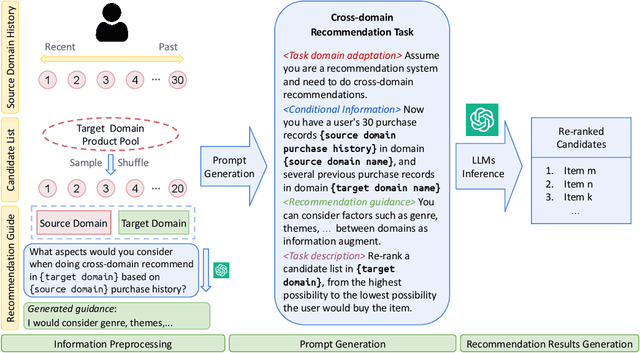


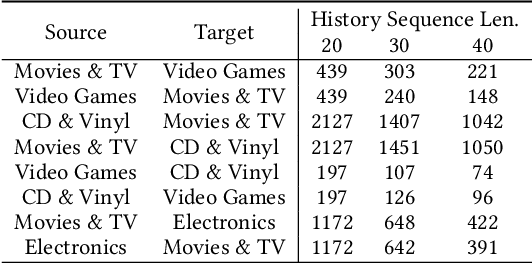
Abstract:Cross-Domain Recommendation (CDR) seeks to enhance item retrieval in low-resource domains by transferring knowledge from high-resource domains. While recent advancements in Large Language Models (LLMs) have demonstrated their potential in Recommender Systems (RS), their ability to effectively transfer domain knowledge for improved recommendations remains underexplored. To bridge this gap, we propose LLM4CDR, a novel CDR pipeline that constructs context-aware prompts by leveraging users' purchase history sequences from a source domain along with shared features between source and target domains. Through extensive experiments, we show that LLM4CDR achieves strong performance, particularly when using LLMs with large parameter sizes and when the source and target domains exhibit smaller domain gaps. For instance, incorporating CD and Vinyl purchase history for recommendations in Movies and TV yields a 64.28 percent MAP 1 improvement. We further investigate key factors including source domain data, domain gap, prompt design, and LLM size, which impact LLM4CDR's effectiveness in CDR tasks. Our results highlight that LLM4CDR excels when leveraging a single, closely related source domain and benefits significantly from larger LLMs. These insights pave the way for future research on LLM-driven cross-domain recommendations.
Transforming the Hybrid Cloud for Emerging AI Workloads
Nov 20, 2024



Abstract:This white paper, developed through close collaboration between IBM Research and UIUC researchers within the IIDAI Institute, envisions transforming hybrid cloud systems to meet the growing complexity of AI workloads through innovative, full-stack co-design approaches, emphasizing usability, manageability, affordability, adaptability, efficiency, and scalability. By integrating cutting-edge technologies such as generative and agentic AI, cross-layer automation and optimization, unified control plane, and composable and adaptive system architecture, the proposed framework addresses critical challenges in energy efficiency, performance, and cost-effectiveness. Incorporating quantum computing as it matures will enable quantum-accelerated simulations for materials science, climate modeling, and other high-impact domains. Collaborative efforts between academia and industry are central to this vision, driving advancements in foundation models for material design and climate solutions, scalable multimodal data processing, and enhanced physics-based AI emulators for applications like weather forecasting and carbon sequestration. Research priorities include advancing AI agentic systems, LLM as an Abstraction (LLMaaA), AI model optimization and unified abstractions across heterogeneous infrastructure, end-to-end edge-cloud transformation, efficient programming model, middleware and platform, secure infrastructure, application-adaptive cloud systems, and new quantum-classical collaborative workflows. These ideas and solutions encompass both theoretical and practical research questions, requiring coordinated input and support from the research community. This joint initiative aims to establish hybrid clouds as secure, efficient, and sustainable platforms, fostering breakthroughs in AI-driven applications and scientific discovery across academia, industry, and society.
MMBind: Unleashing the Potential of Distributed and Heterogeneous Data for Multimodal Learning in IoT
Nov 18, 2024



Abstract:Multimodal sensing systems are increasingly prevalent in various real-world applications. Most existing multimodal learning approaches heavily rely on training with a large amount of complete multimodal data. However, such a setting is impractical in real-world IoT sensing applications where data is typically collected by distributed nodes with heterogeneous data modalities, and is also rarely labeled. In this paper, we propose MMBind, a new framework for multimodal learning on distributed and heterogeneous IoT data. The key idea of MMBind is to construct a pseudo-paired multimodal dataset for model training by binding data from disparate sources and incomplete modalities through a sufficiently descriptive shared modality. We demonstrate that data of different modalities observing similar events, even captured at different times and locations, can be effectively used for multimodal training. Moreover, we propose an adaptive multimodal learning architecture capable of training models with heterogeneous modality combinations, coupled with a weighted contrastive learning approach to handle domain shifts among disparate data. Evaluations on ten real-world multimodal datasets highlight that MMBind outperforms state-of-the-art baselines under varying data incompleteness and domain shift, and holds promise for advancing multimodal foundation model training in IoT applications.
 Add to Chrome
Add to Chrome Add to Firefox
Add to Firefox Add to Edge
Add to Edge